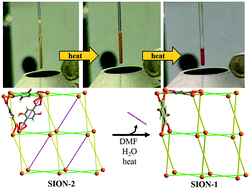Formation pathways of metal–organic frameworks proceeding through partial dissolution of the metastable phase†
Abstract
Understanding how crystalline materials are assembled is important for the rational design of metal–organic frameworks (MOFs), through streamlining their synthesis and controlling their properties for targeted applications. Herein, we report for the first time the construction of two 3-dimensional Tb(III) based MOFs; a metastable MOF acting as an intermediate phase, that partially dissolves and transforms into a chemically and thermodynamically stable MOF. This chemical transformation occurs solely in a N,N-dimethylformamide/water solvent mixture, and is triggered when additional energy is provided to the reaction. In situ studies reveal the partial dissolution of the metastable phase after which the MOF components are reassembled into the thermodynamically stable phase. The marked difference in thermal and chemical stability between the kinetically and thermodynamically controlled phases is contrasted by their identical chemical building unit composition.



 Please wait while we load your content...
Please wait while we load your content...